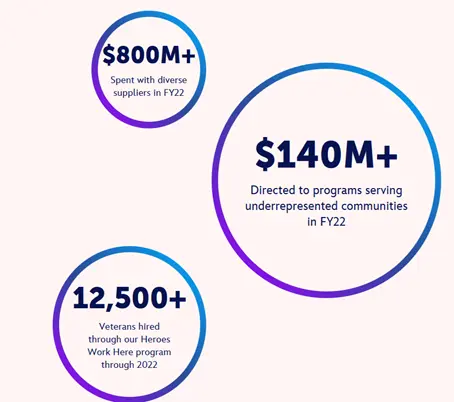Be socially responsible thus sustainable

Knowledge
- Advance understanding of what it means for a business to be socially responsible, what ways can lead to socially responsible operation
- Gain deep knowledge on why social responsibility is important for businesses and how it influences various processes and activities within and outside the business.
- Learning about CSR methods and strategies.
Skills
- Able to investigate how companies can respect and promote human rights within their operations and supply chains.
- Understand the importance of diversity and inclusion in the workplace and be able to identify best practices.
Responsibility & Autonomy
- Independently analyze the social reports, CSR activities of businesses.
- Independently develop and implement strategies related to the wellbeing of workers, appropriate working conditions as well as strategies influencing the social environment of the business.
Environmental, Social, and Governance (ESG) criteria are increasingly recognized as essential components for evaluating a company's overall impact and sustainability. The social dimension of ESG, in particular, focuses on a company's relationships with its employees, suppliers, customers, and the communities in which it operates. Understanding the importance of the social aspects of ESG is crucial for businesses striving to achieve long-term success and societal impact. Embracing social aspects within ESG not only contributes to a positive societal impact but also drives business growth and resilience in an increasingly socially-conscious market. Social dimension is about human rights and equity – an organization’s relationships with people, as well as its policies and actions that impact individuals, groups, and society. In a business context, it examines all people's interactions against principles of ethics, justice, and care for wellbeing. It also covers the CSR activities of businesses.
This WebQuest will guide you to learn more about how important role businesses have in developing the society not only by dealing with their employees and focusing on their working conditions but also by creating, maintaining and developing relationships with the wider society, with the players of the social environment.
The best way to learn is learning from businesses themselves. Your task will be to get familiar with the social aspects and dimension of ESG that focus on how companies manage relationships with employees, suppliers, customers, and communities. After getting deeper knowledge about the concept, the theoretical aspects as well as concrete examples from businesses, your task will be to select a company and analyze its ESG activities focusing on the social aspects. Based on the findings, you need to prepare a report including your proposals for improvement. As the last step, share your thoughts with the company representatives to discuss whether your suggestions can be feasible.
Follow the steps listed below.
1. Team up
Working in a team is efficient to complete this task, since there are various social aspects related to ESG principles, so you can cover as many fields as you can in a team work. Create teams of 3 people. Once you have found your teammates, move on to the next step!
2. Get an idea of the social dimension of ESG as well as CSR
Start with collecting information about the ESG principles in general, then focus on the social (S) dimension of the framework. By searching in the resources, you can learn about why social development is important in the green transformation of businesses, how different measures, policies and strategies may lead to more satisfied workers and better relationships within the company, resulting in more efficient work. You can freely search for additional sources if you decide so. During investigating the theoretical background, try to distinguish business strategies and activities that have impact on the internal environment and the external environment (e.g. CSR).
3. Explore Sustainable Social Strategies
In this phase, your task will be to find out how businesses realize their social approach in their ESG strategies, what ways they follow, what methods they apply to achieve long-term sustainability and the desired social satisfaction.
Investigate what constitutes good labor practices, including fair wages, safe working conditions, and employee rights. You may also search for practices for ethical supply chains or non-discriminative policies concerning race, gender, sexual orientation etc. In your research, it is recommended to collect information about workforce diversity, inclusion as well as community engagement practices.
Search on the web and see the unlimited possible forms of CSR activities, based on the needs and the characteristics of the external business environment.
Prepare a collection of case studies including 3 national and 3 international business cases for successful CSR activities.
4. Putting Theory into Practice - Living Lab Activity:
- Select and contact a company that you wish to analyze. Explain them briefly the task.
- Do a pre-analysis about the company using the information available on the web.
- Get together and make a draft for the interview questions and the topics you wish to focus on, and people you wish to interview during the research, using your knowledge about ESG.
- Do the primary (by interviews) and secondary research (desk research, analysis of documents, reports, policies, strategies, processes etc.) on the application of social aspects within ESG in the selected company.
- Get together and evaluate the information you gained, discuss your impressions you got, results you gained.
- If you still have some questions unanswered or something you are not sure, ask for confirmation from the company.
- Based on the information you collected and analyzed, make a summary, like an executive summary of 4-5 pages including the most important and relevant information about how social aspects are taken into account at the selected company. Prepare graphs, figures that can help the understanding. Create a mind map or infographic that outlines the key components of the social dimension of ESG according to the operation of the company.
- As an additional document, highlight the hot spots where urgent measures must be made (preferably 2-3 if there are any) and make a list of key suggestions/recommendations (approx. 5) for the improvement of the situation, how the company can perform better in this matter.
5. Sharing the results with the representatives of businesses
In order to test your research findings, organize a meeting (with the help of your lecturer) with the representatives of the selected companies when your team can present your research process, applied methods highlighting the findings. To enable the audience to understand properly what you wish to share, make a presentation in power point or by using other tools/programs to focus on visual display too. It is best if all the members of the team take part in the presentation, explaining certain parts of the research. After the presentation, hand out the executive summary to the lecturer and the representatives of the businesses and open the Q/A session. Please get prepared to answer questions raised by the audience or to listen to their comments or remarks.
Well done!
- ESG strategies - ESG Strategy
- ESG social aspects - ESG 101: What Does Social in ESG Mean? | Blog | OneTrust
- social aspect of ESG - The social aspect of ESG
- social factors - Social factors (S in ESG) | Definition, Areas of Interests, & Impacts
- Blog: ESG’s Social pillar
- ESG strategy - A beginner's guide to developing your ESG strategy in 2024
- BSR - a sustainable business network and consultancy focused on creating a world in which all people can thrive on a healthy planet.
- CSR - What is Corporate Social Responsibility (CSR)? | Definition from TechTarget
- What is CSR? | UNIDO
- CSR - CSR Meaning: All You Need to Know
- ESG reporting - How to write an ESG report - a step-by-step guide
Companies are increasingly recognizing their role and responsibility in addressing social issues that impact society at large. Adopting socially responsible practices not only benefits communities but also contributes to a company’s long-term success as well as sustainable development. The social aspect of ESG extends beyond reputation management. Studies have shown that companies with strong social performance often outperform their peers financially. Customer loyalty, employee morale, and stakeholder trust are interdependent factors that contribute to sustained business success. Understanding these dynamics allows companies to align their social goals with their financial objectives.
Sustainability – Coca Cola

As a brand, Coca-Cola is putting a huge focus on sustainability. The key areas are climate, packaging and agriculture along with water stewardship and product quality.
Their message is ‘a world without waste’, with the aim of collecting and recycling every bottle, making their packaging 100% recyclable and replacing all water used in creating their drinks back to the environment to ensure water security. They aim that by 2030, they will have reduced their carbon footprint by 25%. A number of years ago Coca-Cola unveiled its first bottle made from 100% plant-based plastic. “Our goal is to develop sustainable solutions for the entire industry. We want other companies to join us and move forward, collectively. We don’t see renewable or recycled content as areas where we want competitive advantage,” said Dana Breed, Global R&D Director, Packaging and Sustainability, The Coca-Cola Company.
Employee rights: Netflix & Spotify
From a social perspective, companies such as Netflix and Spotify offer benefits to support their employees and families. Netflix offers 52 weeks of paid parental leave to the birth parent and non-birth parent (which includes adopted children). This can be taken at any time whether it is the first year of the child's life or another time that suits their needs. This compares to a median of 18 weeks at other major tech companies. Spotify offers a similar program, although for a shorter duration of 24 weeks of paid leave but employees can take parental leave until their child is three years of age. The program also allows employees one month of flexible work when they return to help transition from being a full-time parent to a full-time employee. When it comes to social causes, Netflix and Spotify use their social media platforms to show support for movements such as Pride Month, environmental sustainability, and Black Lives Matter. Netflix sets an example of how to target - and appeal to - niche and minority audiences through clever social media. Its channel ‘Strong Black Lead’ is just one example.
Links:
Netflix’s Exceptional Parental Leave Policy: A Beacon of Support and Inclusivity
Parental Leave Is Not A Vacation, But It Is A Blessing
Local communities – The Walt Disney Company

Link:
impact.disney.com
